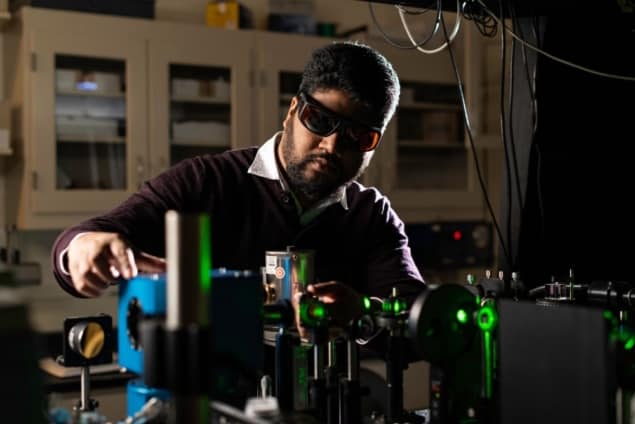
This article reports on research described in a paper in Nature. This paper has since been retracted by the journal.
Superconductivity has been observed at 20 °C (294 K) in a nitrogen-doped lutetium hydride under a pressure of 1 GPa (10 kbar). The material was made and studied by Ranga Dias and colleagues at the University of Rochester in the US, who claim that the finding raises hopes that a material that superconducts at ambient conditions may soon be found.
Being able to carry electrical current with no electrical resistance, superconductors have a wide range of applications. But practical devices that use superconducting components, such as the magnets in magnetic resonance imaging machines, must be chilled to ultralow temperatures to ensure the material superconducts. Condensed-matter physicists have therefore long hoped to develop materials that superconduct at room temperature, which would slash the costs of operating such devices.
For many years, the materials with the highest superconducting transition temperatures were the copper-oxide-based “cuprates”, which superconduct when cooled to below around –130 °C at ambient pressure. But then in 2015 Mikhail Eremets and colleagues at the Max Planck Institute for Chemistry and the Johannes Gutenberg University Mainz, both in Germany, observed superconductivity at –70 °C in a sample of hydrogen sulphide albeit at pressures of about 150 GPa.
Four years later, Eremets’ team and a group led by Russell Hemley at George Washington University in the US reported superconductivity at temperatures up to about –20 °C at similar high pressures. Then in October 2020, Dias and colleagues claimed in the journal Nature to have discovered superconductivity at a balmy 15 °C in a hydrogen sulphide material.
Dias’s paper hit the headline and was included by Physics World in its Breakthroughs of the Year for 2020. The superconductor in question was made by adding carbon to hydrogen sulphide and then squeezing the sample to 220 GPa. Dias’s team found a maximum superconducting temperature of 15 °C occurring at about 260 GPa.
Concerns were raised over the finding, however, and the paper was subsequently retracted in September 2022 by editors at Nature. However, Dias and colleagues maintain that they stand by their results. Indeed, Dias says that the 2020 paper has since been resubmitted to Nature with new data that, he and his team claim, validate the earlier work.
High hopes
Now, Dias and colleagues are back with a new material and one that superconducts at room temperature under less pressure than previous efforts. Dias’s team created it from a gaseous mixture of 99% hydrogen and 1% nitrogen that was place in a reaction chamber with a pure sample of lutetium. The components were left to react for a couple of days at about 200 °C.
The resulting lutetium-nitrogen-hydrogen compound was initially a blue colour. But the sample then turned pink as it was squeezed under pressure, with its change of colour coinciding with the onset of superconductivity at a temperature of –102 °C and pressure of 0.5 GPa.
The scientific community expects that this time the synthesis will be described in great detail
Mikhail Eremets
But when the team compressed the sample to still higher pressures, the team observed a maximum superconducting transition temperature of 20 °C at a pressure of 1 GPa. The material therefore has the highest temperature ever recorded at such low pressures.
Eventually, when the material was compressed beyond 1 GPa, the sample became non-superconducting again and its colour changed again as it turned into a metal. “It was a very bright red,” says Dias. “I was shocked to see colours of this intensity.”
Given the controversial nature of their previous work, the researchers made various measurements to show that the phase was indeed superconducting. In particular, they recorded the electrical resistance showing it dropped to zero at the transition temperature.
The researchers also measured the magnetic susceptibility, observing that the material expelled magnetic field lines, which is another characteristic of a superconductor. Finally, they measured the specific heat, which also showed a characteristic response at the transition temperature.
The team says, however, that further work will be needed to determine the exact stoichiometry of hydrogen and nitrogen in the sample and their atomic positions. While the authors carried out X-ray scattering to determine the crystallographic structure of the sample, they could not determine the precise location of the hydrogen and nitrogen atoms, which could be resolved via neutron scattering in future studies. Show us your metal
Eremets, who was not involved in the new work, told Physics World that the superconductivity seems to be “proven comprehensively” by electrical transport, magnetic susceptibility, heat capacity and other measurements. But he admits that it will be “of paramount importance” to reproduce and confirm the current claim with additional tests.
“The data of the [2020] retracted paper also looked good but the claimed [room-temperature superconductivity] has not been reproduced in careful experimental and theoretical studies,” he says.
Eremets adds that it is important that the authors “provide all necessary information and support for a smooth reproduction” of the sample and the results. “The scientific community expects that this time the synthesis will be described in great detail,” he says. “If it were not possible for other researchers to reproduce the synthesis, it would be important that authors distribute samples for validation.”
The research is described in Nature.



